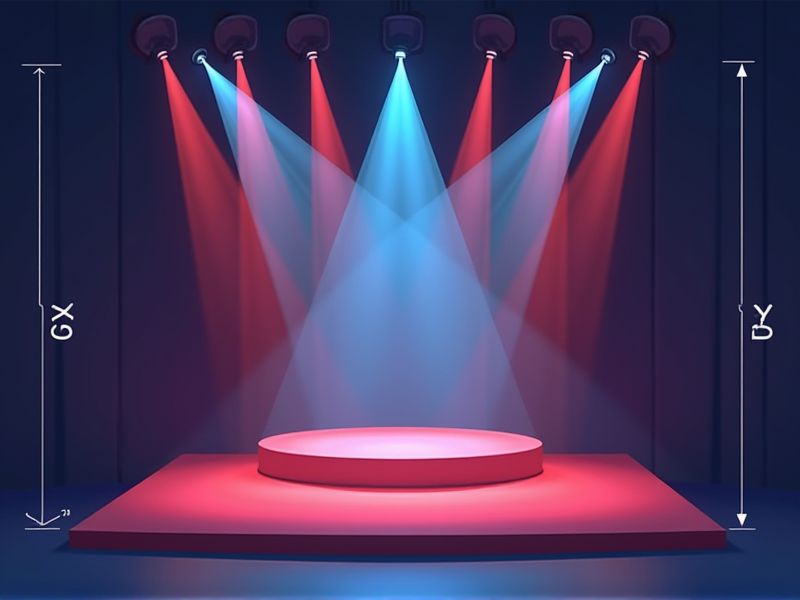
When planning a concert stage, standard dimensions typically range from 40 to 60 feet wide and 30 to 40 feet deep, with a height of 4 to 6 feet above the ground. These measurements provide enough space to accommodate a full band setup, lighting, audio equipment, and allow for adequate performer movement. For larger concerts or festivals, the stage might be expanded to 80 feet or wider, depending on production needs. Always consider your specific event requirements and consult with staging professionals to ensure the chosen dimensions meet safety regulations and audience capacity.
Width: 40-60 Feet
The standard width for concert stages typically ranges from 40 to 60 feet, providing ample space for performers and equipment. This dimension ensures optimal visibility for the audience while accommodating various performance types, from small bands to large orchestras. A wider stage enhances sound dispersion, allowing for a more immersive experience. When planning your event, consider these measurements to create an engaging atmosphere for both artists and spectators.
Depth: 20-40 Feet
A concert stage typically emphasizes a depth range of 20 to 40 feet, allowing for optimal audience engagement and sound projection. This depth dimension creates an immersive experience, ensuring that performers are visually connected with the audience while enabling effective acoustics. Staging designs often incorporate risers and lighting setups within this range to enhance visibility and focus. For your next event, consider the advantages of this depth standard to elevate the overall concert experience.
Height: 4-6 Feet
The standard height for concert stages typically ranges from 4 to 6 feet, providing optimal visibility for the audience. This elevation ensures that viewers from various seating sections can enjoy an unobstructed view of the performers. A height of 5 feet is often considered ideal, balancing sightlines and acoustics for an immersive experience. If you're planning an event, adhering to this height standard can significantly enhance audience engagement and overall satisfaction.
Ceiling Clearance: 25-30 Feet
A standard concert stage requires a ceiling clearance of 25 to 30 feet to accommodate elaborate lighting setups and sound equipment. This height enhances acoustics by allowing optimal sound dispersion, ensuring that you experience clear audio regardless of your location in the venue. In addition, sufficient clearance provides space for aerial performances or rigging setups, contributing to the overall visual impact of the concert. Proper planning for this dimension is essential for successful event execution.
Wing Space: 8-12 Feet Each Side
The standard for concert stage wing space is typically set between 8 to 12 feet on each side, providing essential room for performers and equipment. This designated area allows for smooth transitions and quick access for stage crew, ensuring that shows run efficiently. Adequate wing space enhances both audience experience and performer safety during live events. When planning your event, consider these dimensions to optimize stage functionality and fluidity.
Load Capacity: 125 Pounds Per Square Foot
The standard load capacity for concert stages is 125 pounds per square foot, ensuring safe and reliable support for various equipment and performers. This specification is crucial for event planners and venue managers to consider when designing stage layouts and selecting materials. Proper assessment of this load capacity helps prevent accidents and guarantees the stability of heavy sound systems and lighting rigs. When orchestrating your event, verifying adherence to this standard will enhance safety and performance quality.
Equipment Cutout: 10X10 Feet
The standard concert stage equipment cutout measures 10x10 feet, providing ample space for essential gear. This size accommodates a variety of equipment setups, ensuring optimal placement for sound and lighting systems. With a focus on functionality, the cutout allows sound engineers and technicians to work efficiently during performances. When planning your event, consider how the 10x10 feet area can enhance the overall production quality and audience experience.
Front-Of-House Area: 10-15 Feet
The standard focus area for a concert stage, particularly in the Front-of-House (FOH) region, typically spans 10 to 15 feet. This designated zone is crucial for optimal sound quality and audience engagement, allowing sound engineers to fine-tune audio levels effectively. In this range, acoustics are enhanced, ensuring a clearer and more immersive experience for attendees. Ensuring your setup adheres to this standard can significantly improve the overall concert atmosphere.
Backstage Space: 10-20 Feet Deep
The standard depth for a concert stage's backstage space typically ranges from 10 to 20 feet, allowing for efficient movement and organization of equipment and personnel. This area is crucial for storing instruments, providing dressing rooms, and accommodating technical staff without intruding on the audience's experience. Ensuring this depth not only enhances logistics but also optimizes the performer's transition on and off stage. By adhering to this standard, venues can facilitate smoother operations during events, enhancing overall performance quality.
Sound And Light Rigging: 1,000-2,000 Pounds Capacity
The standard concert stage typically features sound and light rigging with a remarkable capacity ranging from 1,000 to 2,000 pounds. This weight allowance ensures robust support for complex lighting systems, heavy speakers, and advanced sound equipment, essential for creating an immersive auditory experience. Rigging systems are meticulously designed to distribute weight evenly, minimizing the risk of accidents and enhancing stage stability. By understanding these specifications, you can appreciate the intricate engineering that elevates live performances to a spectacular level.
